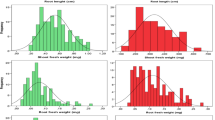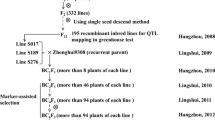Abstract
Phosphorus (P) deficiency tolerance is a pivotal trait for plant growth and development. Most of the commercial modern cultivars lack this trait and reported it as a very serious problem limiting crop productivity. This trait is advantageous if present in modern high yielding varieties as it increases the yield under the phosphorus-deficient soil conditions. With the importance of phosphorus deficiency tolerance, the present investigation was carried out with an objective to screen for tolerance to phosphorus deficiency using solution culture and phosphorus uptake 1 (Pup1) locus linked markers in 30 diverse rice genotypes. A wide range of varied responses to P deficiency in rice genotypes for all the traits were observed. Root length and enzyme activity showed increased mean performance under the − P condition when compared to + P condition. Medium to high heritability estimates were obtained for most of the traits. Correlation analysis showed that the traits: root P content, fresh shoot weight, dry shoot weight, and shoot length showed highly significant correlations with each other under − P conditions. Based on the hydroponics and molecular screening, three genotypes viz., ADT (R) 48, Improved Pusa Basmati 1 and UPLRI 5 were classified as tolerant for its response to P deficiency as they possessed significant increase in desirable root and shoot traits, increased acid phosphatase enzyme and these genotypes also possessed the Pup1 allele for all the five markers. The selected genotypes may be useful for the exploration of novel genes conferring phosphorus deficiency tolerance and used as donor parents in the breeding programs. Absence of this allele in the rice genotypes viz., drought tolerant (Anna (R) 4) and submergence tolerant (CR 1009 Sub 1) may warrant the development of multiple abiotic stress tolerance cultivars for upland and submergence cropping systems in future rice breeding program.




Similar content being viewed by others
References
Ali J, Jewel ZA, Mahender A, Anandan A, Hernandez J, Li Z (2018) Molecular genetics and breeding for nutrient use efficiency in rice. Int J Mol Sci 19(6):1762. https://doi.org/10.3390/ijms19061762
Aluwihare YC, Chamikara MD, Dissanayake DR, Karannagoda NN, Sirisena DN, Samarasinghe WL, Rajapakse S, Sooriyapathirana SD (2015) Validation of K46, a Pup1-linked marker, using a selection of Sri Lankan rice (Oryza sativa L.) germplasm for marker assisted selection towards phosphorous deficiency tolerance. Ceylon J Sci (Bio Sci) 44(2):45–54. https://doi.org/10.4038/cjsbs.v44i2.7349
Aluwihare YC, Ishan M, Chamikara MDM, Weebadde CK, Sirisena DN, Samarasinghe WLG, Sooriyapathirana SDSS (2016) Characterization and selection of phosphorus deficiency tolerant rice genotypes in Sri Lanka. Rice Sci 23(4):184–195. https://doi.org/10.1016/j.rsci.2015.10.001
Anila M, Swamy HM, Kale RR, Bhadana VP, Anantha MS, Hajira SK, Balachiranjeevi CH, Dass MA, Bhaskar S, Dilip T, Pranathi K (2018) Breeding lines of the Indian mega-rice variety, MTU 1010, possessing protein kinase OsPSTOL (Pup1), show better root system architecture and higher yield in soils with low phosphorus. Mol Breed 38(12):147. https://doi.org/10.1007/s11032-018-0903-1
Chankaew S, Monkham T, Pinta W, Sanitchon J, Kaewpradit W, Srinives P (2019) Screening tolerance to phosphorus deficiency and validation of phosphorus uptake 1 (Pup1) gene-linked markers in Thai indigenous upland rice germplasm. Agronomy 9(2):81. https://doi.org/10.3390/agronomy9020081
Chin JH, Gamuyao R, Dalid C, Bustamam M, Prasetiyono J, Moeljopawiro S, Wissuwa M, Heuer S (2011) Developing rice with high yield under phosphorus deficiency: Pup1 sequence to application. Plant physiol 156(3):1202–1216. https://doi.org/10.1104/pp.111.175471
Chin JH, Lu X, Haefele SM, Gamuyao R, Ismail A, Wissuwa M, Heuer S (2010) Development and application of gene-based markers for the major rice QTL phosphorus uptake 1. Theor Appl Genet 120(6):1073–1086. https://doi.org/10.1007/s00122-009-1235-7
Chithrameenal K, Vellaikumar S, Ramalingam J (2017) Identification of rice (Oryza sativa L.) genotypes with high phosphorus use efficiency (PUE) under field and hydroponic conditions. Indian Res Genet Biotech 9:23–37
Dey P, Santhi R, Maragatham S, Sellamuthu KM (2017) Status of phosphorus and potassium in the Indian soils vis-à-vis world soils. Indian J Fert 13(4):44–59
Dissanayaka DMSB, Plaxton WC, Lambers H, Siebers M, Marambe B, Wasaki J (2018) Molecular mechanisms underpinning phosphorus-use efficiency in rice. Plant Cell Environ 41(7):1483–1496. https://doi.org/10.1111/pce.13191
Fageria NK, Baligar VC (1997) Upland rice genotypes evaluation for phosphorus use efficiency. J Plant Nutr 20(4):499–509. https://doi.org/10.1080/01904169709365270
Fageria NK, Wright RJ, Baligar VC (1988) Rice cultivar evaluation for phosphorus use efficiency. Plant Soil 111:105–109. https://doi.org/10.1007/BF02182043
FAO (Food Agriculture Organization) (2018) Rice market monitor. https://www.fao.org/economic/est/publications/rice-publications/rice-market-monitor-rmm/en/
Fitter AH, Caldwell MM, Pearcy RW (1994) Architecture and biomass allocation as components of the plastic response of root systems to soil heterogeneity. Exploitation of environmental heterogeneity by plants: ecophysiological processes above-and belowground. Academic Press Limited, London, pp 305–323
Gamuyao R, Chin JH, Pariasca-Tanaka J, Pesaresi P, Catausan S, Dalid C, Slamet-Loedin I, Tecson-Mendoza EM, Wissuwa M, Heuer S (2012) The protein kinase from traditional OsPSTOL 1 rice confers tolerance of phosphorus deficiency. Nature 488:535–539. https://doi.org/10.1038/nature11346
Gunes A, Inal A, Alpaslan M, Cakmak I (2006) Genotypic variation in phosphorus efficiency between wheat cultivars grown under greenhouse and field conditions. Soil Sci Plant Nutr 52(4):470–478. https://doi.org/10.1111/j.1747-0765.2006.00068.x
Guo YC, Lin WX, Shi QM, Liang YY, Chen FY, He HQ, Liang KJ (2002) Study on the screening of high phosphorus efficiency genotypes at rice seedling stage. Chin J Appl Ecol 13(12):1587–1591
Guo ZH, He LY, Huang W, Xu CG (2006) Screening of rice for tolerance to low phosphorus stress. J Plant Nutr Fertil 12:642–648
Haefele SM, Hijmans RJ (2007) Soil quality in rice-based rainfed lowlands of Asia: characterization and distribution. In: Aggarwal PK, Ladha JK, Singh RK, Devakumar C, Hardy B (eds) Proceedings of the 26th international rice research conference, October 9–12, 2006, New Delhi, India, pp 297–308
Heuer S, Lu X, Chin JH, Tanaka JP, Kanamori H, Matsumoto T, De Leon T, Ulat VJ, Ismail AM, Yano M, Wissuwa M (2009) Comparative sequence analyses of the major quantitative trait locus phosphorus uptake 1 (Pup1) reveal a complex genetic structure. Plant Biotechnol J 7:456–471. https://doi.org/10.1111/j.1467-7652.2009.00415.x
Johnson HW, Robinson HF, Comstock RE (1955) Estimates of genetic and environmental variability in soyabeans. Agron J 47:314–318. https://doi.org/10.2134/agronj1955.00021962004700070009x
Kavanova M, Grimoldi AA, Lattanzi FA, Schnyder H (2006) Phosphorus nutrition and mycorrhiza effects on grass leaf growth. P status- and size mediated effects on growth zone kinematics. Plant Cell Environ 29(4):511–520. https://doi.org/10.1111/j.1365-3040.2005.01428.x
Kochian LV, Hoekenga OA, Pineros MA (2004) How do crop plants tolerate acid soils? Mechanisms of aluminum tolerance and phosphorous efficiency. Annu Rev Plant Biol 55:459–493. https://doi.org/10.1146/annurev.arplant.55.031903.141655
Li J, Xie Y, Dai A, Liu L, Li Z (2009) Root and shoot traits responses to phosphorus deficiency and QTL analysis at seedling stage using introgression lines of rice. J Genet Genom 36:173–183. https://doi.org/10.1016/S1673-8527(08)60104-6 (PMID: 19302973)
Lim JH, Chung IM, Ryu SS, Park MR, Yun SJ (2003) Differential responses of rice acid phosphatase activities and isoforms to phosphorus deprivation. J Biochem Mol Biol 36(6):597–602. https://doi.org/10.5483/bmbrep.2003.36.6.597
López-Bucio J, Cruz-Ramırez A, Herrera-Estrella L (2003) The role of nutrient availability in regulating root architecture. Curr Opin Plant Biol 6(3):280–287. https://doi.org/10.1016/s1369-5266(03)00035-9
Lush JL (1940) Intra-sire correlations or regressions of offspring on dam as a method of estimating heritability of characteristics. Proc Am Soc Anim Prod 1940:293–301
Meeks M, Murray SC, Hague S, Hays D (2013) Measuring maize seedling drought response in search of tolerant germplasm. Agronomy 3(1):135–147. https://doi.org/10.3390/agronomy3010135
Mehra P, Pandey BK, Giri J (2017) Improvement in phosphate acquisition and utilization by a secretory purple acid phosphatase (OsPAP21b) in rice. Plant Biotechnol J 15(8):1054–1067. https://doi.org/10.1111/pbi.12699
Murray MG, Thompson WF (1980) Rapid isolation of high molecular weight plant DNA. Nucleic Acids Res 8:4321–4325. https://doi.org/10.1093/nar/8.19.4321
Pandit E, Panda RK, Pani DR, Chandra R, Singh S, Pradhan SK (2018) Molecular marker and phenotypic analyses for low phosphorus stress tolerance in cultivars and landraces of upland rice under irrigated and drought situations. Indian J Genet 78(1):59–68. https://doi.org/10.5958/0975-6906.2018.00007.X
Pandit E, Sahoo A, Panda RK, Mohanty DP, Pani DR, Anandan A, Pradhan SK (2016) Survey of rice cultivars and landraces of upland ecology for phosphorous uptake 1 (Pup1) QTL using linked and gene specific molecular markers. Oryza 53(1):1–9
Panigrahy M, Rao DN, Yugandhar P, Raju NS, Krishnamurthy P, Voleti SR, Reddy GA, Mohapatra T, Robin S, Singh AK (2014) Hydroponic experiment for identification of tolerance traits developed by rice Nagina 22 mutants to low-phosphorus in field condition. Arch Agron Soil Sci 60(4):565–576. https://doi.org/10.1080/03650340.2013.821197
Piper CS (1966) Soil and plant analysis. Hans Publishers, Bombay, India
Prasetiyono J, Aswidinnoor H, Moeljopawiro S, Sopandie D, Bustamam M (2010) Identification of polymorphic marker for breeding of rice tolerant to phosphorus deficiency. Indones J Agric 3(1):1–8
Raghothama KG, Karthikeyan AS (2005) Phosphate acquisition. Plant Soil 274:37–49. https://doi.org/10.1007/s11104-004-2005-6
Ray DK, Mueller ND, West PC, Foley JA (2013) Yield trends are insufficient to double global crop production by 2050. PLoS ONE 8(6):e66428. https://doi.org/10.1371/journal.pone.0066428
Robinson HF, Comstock RE, Harvey PH (1949) Estimates of heritability and the degree of dominance in corn. Agron J 41(8):353–359. https://doi.org/10.2134/agronj1949.00021962004100080005x
Sadasivam S, Manickam A (1996) Biochemical methods. New Age International Publishers, New Delhi
Santos OJ, Gonçalves LS, Scapim CA, de SM De Sousa, Castro CR, Baba VY, de Oliveira AL (2016) Screening of inbred popcorn lines for tolerance to low phosphorus. Genet Mol Res. http://dx.doi.org/https://doi.org/10.4238/gmr.15027519
Searle SR (1965) The value of indirect selection: I Mass selection. Biometrics 21:682–707
Shimizu A, Yanagihara S, Kawasaki S, Ikehashi H (2004) Phosphorus deficiency-induced root elongation and its QTL in rice (Oryza sativa L.). Theor Appl Genet 109:1361–1368. https://doi.org/10.1007/s00122-004-1751-4
Swamy HKM, Anila M, Kale RR, Bhadana VP, Anantha MS, Brajendra P, Hajira SK, Balachiranjeevi CH, Prasanna BL, Pranathi K, Dilip T, Bhaskar S, Kumar VA, Kousik MBVN, Harika G, Swapnil K, Rekha G, Cheralu C, Shankar VG, Reddy SN, Kumar S, Balachandran SM, Madhav MS, Kumar RM, Sundaram RM (2019) Phenotypic and molecular characterization of rice germplasm lines and identification of novel source for low soil phosphorus tolerance in rice. Euphytica 215(7):118. https://doi.org/10.1007/s10681-019-2443-0
Tadano T, Ozawa K, Sakai H, Osaki M, Matsui H (1993) Secretion of acid phosphatase by the roots of crop plants under phosphorus-deficient conditions and some properties of the enzyme secreted by lupin roots. In: Plant nutrition-from genetic engineering to field practice. Springer, Dordrecht, pp 99–102
Tyagi W, Rai M, Dohling A (2012) Haplotype analysis for Pup1 locus in rice genotypes of North Eastern and Eastern India to identify suitable donors tolerant to low phosphorus. SABRAO J Breed Genet 44(2):398–405
Wissuwa M (2003) How do plants achieve tolerance to phosphorus deficiency? Small causes with big effects. Plant Physiol 133(4):1947–1958. https://doi.org/10.1104/pp.103.029306
Wissuwa M, Ae N (2001) Genotypic variation for tolerance to phosphorus deficiency in rice and the potential for its exploitation in rice improvement. Plant Breed 120(1):43–48. https://doi.org/10.1046/j.1439-0523.2001.00561.x
Wissuwa M, Wegner J, Ae N, Yano M (2002) Substitution mapping of Pup1: a major QTL increasing phosphorus uptake of rice from a phosphorus-deficient soil. Theor Appl Genet 105(6–7):890–897. https://doi.org/10.1007/s00122-002-1051-9
Wissuwa M, Yano M, Ae N (1998) Mapping of QTLs for phosphorus-deficiency tolerance in rice (Oryza sativa L.). Theor Appl Genet 97(5–6):777–783. https://doi.org/10.1007/s001220050955
Yoshida S, Parao FT (1976) Climatic influence on yield and yield components of lowland rice in the tropics. Clim Rice 20:471–494
Yugandhar P, Nallamothu V, Panigrahy M, Tipireddy S, Bhadana VP, Voleti SR, Desiraju S, Mangrauthia SK, Neelamraju S (2018) Nagina 22 mutants tolerant or sensitive to low P in field show contrasting response to double P in hydroponics and pots. Arch Agron Soil Sci 64(14):1975–1987. https://doi.org/10.1080/03650340.2018.1471684
Acknowledgements
This work was financially supported through grants from the Department of Biotechnology, Ministry of Science and Technology, Government of India—DBT Bio-CARe program (BT /PR19063/ BIC/ 101/ 975/ 2016). Authors wish to acknowledge the Centre of Innovation (CI) and Department of Plant Breeding and Genetics, Agricultural College and Research Institute, Tamil Nadu Agricultural University, Madurai for providing field and laboratory facilities.
Author information
Authors and Affiliations
Corresponding author
Additional information
Publisher's Note
Springer Nature remains neutral with regard to jurisdictional claims in published maps and institutional affiliations.
Electronic supplementary material
Below is the link to the electronic supplementary material.
Rights and permissions
About this article
Cite this article
Nirubana, V., Vanniarajan, C., Aananthi, N. et al. Screening tolerance to phosphorus starvation and haplotype analysis using phosphorus uptake 1 (Pup1) QTL linked markers in rice genotypes. Physiol Mol Biol Plants 26, 2355–2369 (2020). https://doi.org/10.1007/s12298-020-00903-1
Received:
Revised:
Accepted:
Published:
Issue Date:
DOI: https://doi.org/10.1007/s12298-020-00903-1




